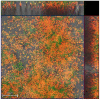Mucoadhesive Pharmacology: Latest Clinical Technology in Antiseptic Gels
- PMID: 38247746
- PMCID: PMC10815608
- DOI: 10.3390/gels10010023
Mucoadhesive Pharmacology: Latest Clinical Technology in Antiseptic Gels
Abstract
Chlorhexidine (CHX) is one of the most widely used antiseptics in the oral cavity due to its high antimicrobial potential. However, many authors have stated that the effect of CHX in nonsurgical periodontal therapy is hampered by its rapid elimination from the oral environment. The aim of this study was to determine the antibacterial efficacy of a new compound of chlorhexidine 0.20% + cymenol (CYM) 0.10% on a multispecies biofilm. For this, an in vitro study was designed using a multispecies biofilm model of Streptococcus mutans, Fusobacterium nucleatum, Prevotella intermedia, and Porphyromonas gingivalis. Quantification of the microbial viability of the biofilm was performed using 5-cyano-2,3-ditolyl tetrazolium-chloride (CTC) to calculate the percentage of survival, and the biofilms were observed using a a confocal laser scanning microscopy (CLSM). It was observed that the bactericidal activity of the CHX + cymenol bioadhesive gel was superior to that of the CHX bioadhesive gel, in addition to higher penetrability into the biofilm. Therefore, there was greater elimination of bacterial biofilm with the new compound of chlorhexidine 0.2% plus cymenol 0.1% in a bioadhesive gel form compared to the formulation with only chlorhexidine 0.2% in a bioadhesive gel form.
Keywords: antibacterial gels; antimicrobial gels; chlorhexidine; cymenol; periodontal application; substantivity.
Conflict of interest statement
The authors declare no conflicts of interest.
Figures



References
-
- Lizambard M., Menu T., Fossart M., Bassand C., Agossa K., Huck O., Neut C., Siepmann F. In-situ forming implants for the treatment of periodontal diseases: Simultaneous controlled release of an antiseptic and an anti-inflammatory drug. Int. J. Pharm. 2019;572:118833. doi: 10.1016/j.ijpharm.2019.118833. - DOI - PubMed
-
- Aguilera F.R., Viñas M., Sierra J.M., Vinuesa T., RFernandez de Henestrosa A., Furmanczyk M., Trullàs C., Jourdan E., López-López J. Sub-stantivity of mouth-rinse formulations containing cetylpyridinium chloride and O-cymen-5-ol: A random-ized-crossover trial. BMC Oral Health. 2022;22:154–196. doi: 10.1186/s12903-022-02688-z. - DOI - PMC - PubMed
-
- Cresols M., Cresols I., Cresols M. Final report on the safety assessment of sodium p-Chloro-m-Cresol, p-Chloro-m-Cresol, Chlorothymol, Mixed Cresols, m-Cresol, o-Cresol, p-Cresol, Isopropyl Cresols, Thymol, o-Cymen-5-ol, and Carvacrol. Int. J. Toxicol. 2006;25:29–127. - PubMed
-
- Lim S.Y., Dafydd M., Ong J.J., Ord-McDermott L.A., Board-Davies E., Sands K., Williams D., Sloan A.J., Heard C.M. Mucoadhesive thin films for the simultaneous delivery of microbicide and anti-inflammatory drugs in the treatment of peri-odontal diseases. Int. J. Pharm. 2020;573:118860. doi: 10.1016/j.ijpharm.2019.118860. - DOI - PubMed
Grants and funding
LinkOut - more resources
Full Text Sources
Molecular Biology Databases

